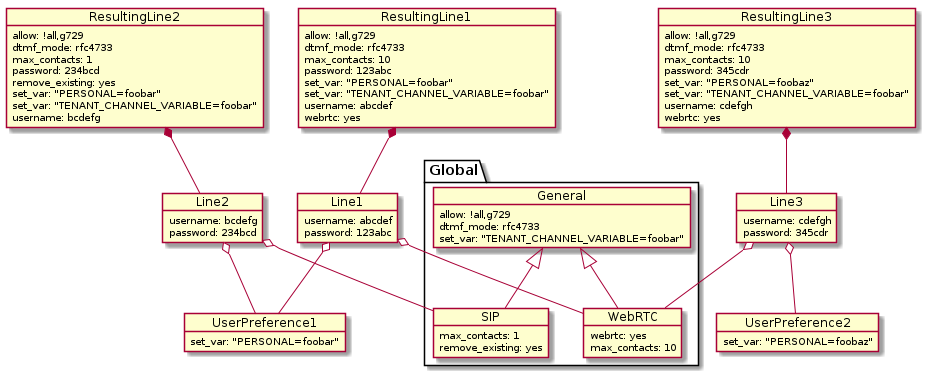A Multi Tenant API for PJSIP
3 March 2020
Towards a Multi Tenant API for PJSIP
Asterisk has been switching from the legacy chan_sip channel driver to a new SIP
stack based on the PJSIP library. We have been using
the new SIP stack in Wazo Platform for over a year now. The way we configure the
SIP channel driver as of Wazo Platform 20.03 still relies on the API that existed for
chan_sip with a translation layer in wazo-confgend to convert the chan_sip
configuration to a chan_pjsip one.
The translation system we are using at the moment does not deliver all the
values we could get from a properly configured chan_pjsip. Moreover, the
standard format of the pjsip.conf file is hard to override without using the
PJSIP Wizard.
We chose to use this change in API to make the SIP configuration as multi tenant as possible.
In this article we will look into the process of making this new API multi tenant.
Differences Between chan_sip and chan_pjsip
chan_sip is the old channel driver that has been in Asterisk for ages to handle
the SIP protocol. For some people this means that it has proved its value over
time and that it's quite stable. But in fact, chan_sip proved to be hard to
maintain. Fixing a bug could result in another unrelated bug to appear.
In order to get the development around SIP more enjoyable, a new channel driver
has been developed using an existing SIP library named PJSIP. One of the core
difference from an administrator point of view is the configuration file. What
used to be a single section for a peer in sip.conf is now multiple sections in
pjsip.conf and many configuration options have changed.
chan_sip also accepted a general section that could be used to set default
values for the whole channel driver.
How Wazo Platform Migrated from chan_sip to chan_pjsip
To be able to move quickly from chan_sip to chan_pjsip, we chose to use a
translation layer to get from a valid chan_sip configuration to a valid
chan_pjsip configuration. This is heavily inspired by the sip_to_pjsip.by
script that is available in the Asterisk source code. This solution was
sufficient to get us started but we have not been able to leverage the full
power of the new SIP channel driver.
A Multi Tenant SIP Configuration
The current SIP configuration is not completely multi tenant. What this means is that there is still a SIP general configuration that is shared by all SIP endpoints, lines and trunks. This general configuration is applied to all tenants of a given engine. The lines and trunks themselves are multi tenant. To make matters worse, the old API did not support configuration templates. So a tenant A that wants a different configuration from the general configuration of its engine would have to replicate that configuration option for all of its endpoints.
The design of the new API for PJSIP is the right opportunity to fix that
situation. In fact, the PJSIP configuration file does not contain a general
section. There still exists some global configuration that is only configurable
by the "owner" of the engine, but all tenants will now be able to have their own
"general" configuration.
The new API will allow a SIP configuration to have parents. A parent is another SIP configuration that is included and which can be overridden. So the configuration of line L1 could contain only two fields: its peer name and password. All other configuration options can be inherited from the general configuration; WebRTC configuration and user preferences configuration for example.

In this example we have three lines owned by two users. Each line inherits from the user's preference template and from the SIP or WebRTC template. The SIP and WebRTC templates inherit from the General template. Each of these templates is owned by a given tenant.
With this configuration granularity, each tenant will have its own general
configuration and will be able to manage the SIP configuration of all of its
endpoints independently from the others without duplicating the configuration
for all of its endpoints.
Reloading
Another problem of the chan_sip channel driver and chan_pjsip with our current
implementation is the need to reload the configuration for each modification.
The new API will leverage a configuration system named
Sorcery. It will allow
each configuration to be updated individually. Every time a configuration change
is done, Wazo Platform will be able to update the modified sections of the configuration
only for the impacted resources instead of reloading the entire channel driver.
Migrating to the New API
As usual, we will do our best to make the migration smooth for everyone. At the time of this writing, the plan is to have all the configuration automatically migrated during the upgrades. Some new features will appear as they are developed and integrated into the product. New forms will be available in wazo-ui.
At the moment, there is no plan to keep the old and new API working together. If you do use the SIP configuration API, get in touch with us on the forum
Conclusion
The new SIP configuration API should allow users to get a more flexible and more
productive workflow. It will also save the administrator from doing some manual
configuration for fields that are not well supported by the SIP to PJSIP
translation layer. And it will allow users of Wazo Platform to leverage the full
power of chan_pjsip.
Discussion
Comments or questions in this forum post.